By Clifford Woods Which Trees Can I Plant Near My Fish Pond? 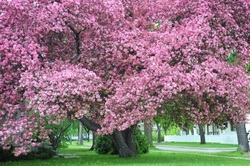 For pond keepers, it is essential to make sure that particular types of tree which are toxic are placed far from your fish pond. Most tree varieties lose their leaves, especially throughout the autumn season. You definitely do not want your pond fish to consume any of the toxic leaves that may fall into your pond; it could ruin their eating habits. On top of that, leaves are not nutritious for any fish.
Regardless of whether the leaves are dangerous or not, the elevated amounts of organic matter dropping into the fish pond is harmful as the leaves will at some point rot and sink to the bottom of the pond. Rotting plant life raises the amounts of carbon dioxide and ammonia in the water, which is extremely bad for the well-being of your fish.
A net spread over the pond is a practical option, yet it does take away from the overall physical appeal and experience of the fish pond. Nets may be necessary, or you could simply select tree species that do not shed a significant number of leaves.
There are some tree varieties that will surely supply a pleasant experience and shade for your goldfish, Koi and other aquatic life in your pond from a scorching summer day. The shade from the trees you choose will help to filter out ultraviolet rays, which subsequently assists in the management of algae. The cooler water allows oxygen to break down from the environment into the water considerably more effortlessly.When deciding upon trees to position around a fish pond, steer clear of the following: Additional types, while not particularly toxic, do possess huge root systems which will at some point hinder your pond liners are Sycamores and Willows. These are just two primarily examples of trees with large root systems that you should keep away from. Here also is a lists of a few trees appropriate for growing in gardens with fish ponds:
- Crab Apples are relatively tiny trees types which are a fantastic choice for gardening around a fish pond. The Japanese Crab Apple, as well as the fragrant Malus Pink Perfection are both excellent possibilities.
- The Swedish Silver Birch is fantastic if you are searching for mild foliage and a bark that progressively becomes white in color as time passes. For those who have an outside Pergola, positioned close to your fish pond and are seeking to add a few evergreen climbing plants next to it ensure that you stay away from deciduous plants like ivy. This particular plant type is among the most toxic of all climbers.
- A number of the ash tree types make the perfect option, since their root system is fairly compact and they tend not to cast an excessive amount of shade. The Mountain Ash tree has umbel-type blossoms in spring, accompanied by vibrant reddish berries in the autumn which are practically eclipsed by the spectacular red vegetation. The Japanese Mountain Ash yields sizeable orange berries.
Additional options are Mays or Hawthorns, especially if you require a tough and hardy plant. For those who desire an autumn look, a Crataegus prunifolia may be a good choice for you.
If you really have a desire for an evergreen deciduous climbing plant, then a Silver Queen is an excellent choice since it grows quickly and scarcely flowers; from time to time it does develop blossoms, however it is simple to prune them.
In case you already have an accumulation of decayed leaves in your pond, it is likely that algae are beginning to form if it hasn't already spread. An algaecide containing beneficial microorganisms is exactly what you need in order to obtain a thriving pond free of all bad bacteria.
 Author: Clifford Woods is the CEO of Effective Environmental Services and Organic Environmental Technology.
We brew Beneficial Microorganisms that eat toxins in the environment and offer Naturally Organic Solutions.
The Basics of Pond Care by Clifford Woods 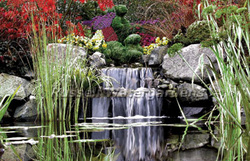 Proper pond care is comparatively straightforward on the condition that the pond is well-made in advance of putting fish into it as well as being properly maintained when in operation.
With both ponds and pools, you need to make sure that the proper water levels are taken care of, either by filling it in excess for the duration of hot weather seasons or depleting it in the course of rainier periods. This will prevent undue weathering of exposed areas of pond liner or erosion of banks if flooding occurs.
Splits in cement or holes in liners can often be fixed, however it is quite time intensive and certainly an issue worthy of avoidance. Appropriately blended cement should never fracture even during extreme climate changes. Most shredding in liners is a result of inappropriate selection of the proper fish pond liner in advance of installation, additional reasons are the feared visits from the otter, heron, raccoon, and other similar animals whose razor-sharp claws can effortlessly pierce weaker pond liners.
Fish Care
Assuming that your pond water is properly oxygenated and fish aren't over-fed, the fish should continue to be healthy. However, if you do observe fish behaving out of character or floating around too lethargically then in that case it is advisable to contact your local pond fish authorities. Protrusions or skin lesions are evident indications of stressed fish and really should be dealt with the instant it is observed.
Once again, a quick call to your own personal local fish pond treatment company to ask for a precise analysis and what therapy should be done is usually adequate to save your pond fish.
Seasonal Care
The later part of the fall and winter are generally not the ideal times of year to thoroughly clean your pond, as you will most likely disrupt all of the vegetation and fish attempting to adapt to the winter season. A few plants send down sprouts to the bottom level of the pond exactly where they sit until the weather conditions become a bit warmer.
The perfect time for an effective clean up is in early spring, following the last frosts, whenever pond life is back to being lively and the fish start to eat actively. Normally it is not recommended to completely drain and clean out ponds as this tends to get rid of the friendly microorganisms as well.
Improve Appearance and Protect Your Pond
To enhance the visual appeal of the pond as well as to protect against disease, get rid of any decaying plant life from the water and small vegetation following the initial couple of frosts at the beginning of fall, excessive floating vegetation that appears lifeless also needs to be taken out with a net or rake.
Fish during this period aren't going to be feeding and will essentially survive on their very own body fats for the rest of the winter season. Be sure you provide them with sufficient protection by means of ledges, rocks, or extremely deep water where they are able to hide securely.
Algae
Green unclean water is a frequent issue with more compact ponds. A small amount of algae exists in all water; having said that, in lengthier intervals of sunlight even an ideal equilibrium of fish and plants is just not sufficient for complete avoidance and the water can becomes a livid green color. In tiny still-water garden ponds this can be prevented with the setup of a purification unit such as UV sterilizers.
The UV light can eliminates algae cells, while the filtration system gets rid of its inactive organic matter well before it can lead to more complications. One particular method for eliminating algae would be to use an algaecide abundant with beneficial microorganisms.
A probiotics solution may be helpful in getting rid of algae completely as well as boost the overall health of the pond environment.

All about Pond Magician and How to Use it Effectively
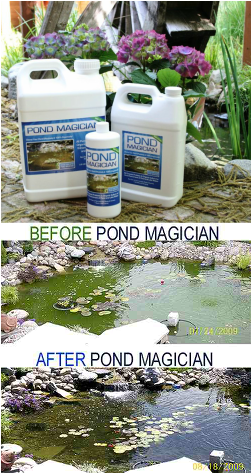 Pond Magician is made up of an incredible number of beneficial microorganisms that maneuver through your pond and consume the microbes and contaminants which make your pond unpleasant as well as foul-smelling.
Unlike similar pond cleaners which exclusively deal with natural materials, Pond Magician is made up of both aerobic and anaerobic beneficial microorganisms, therefore making it easily adaptable to a large selection of pond water situations.
What are Beneficial Microorganisms?
Beneficial microorganisms are composed of billions of friendly microorganisms. Generally, they simply eat up the algae and unwanted organisms. These microbes are advantageous to the water, plants, and fish life that thrive within your pond and they can be extremely eager for the impurities and organisms which make your pond unclean.
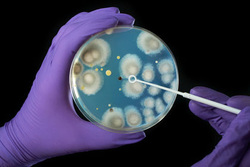 A few of the beneficial microorganisms can flourish even within environments where there is little if any breathable oxygen available. For this reason, beneficial microorganisms are quite effective regardless of the situation. Apart from being less expensive when compared with other deodorizing remedies, the application process is quite easy.
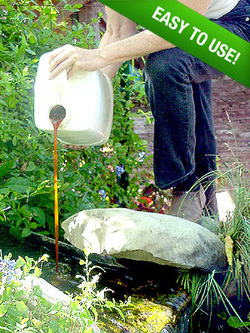 How to Use Pond Magician and Determine the Quantity Needed
Pond Magician is incredibly user-friendly. Simply pour it into your pond directly from the container. Put just a little at a handful of locations around the border of the pond or even dump it into the flow or waterfall for those who have one. The concept is to get the solution equally distributed within the pond.
You may also apply it on top of the pond's surface area with a backyard sprayer. This can help in the case that you have a large amount of surface algae.
Before you apply it, first you have to determine the amount of gallons in your pond by employing this basic formula:
- Multiply the average length in feet of the pond by the average width in feet.
- Then multiply that answer by the average depth in feet.
- Then multiply that answer by 7.48.
- This answer is the approximate number of gallons in your pond.
After that, making use of the guidelines below will determine the quantity of Pond Magician you will need for two applications.
- 0-1,000 Gallons = 1 Quart
- 1000-5000 Gallons = 1 Gallon
- 5,000 - 12,500 Gallons = 2.5 Gallons
- 12,500 Gallons or More = Please give us a call for precise instructions at (818) 897-4444
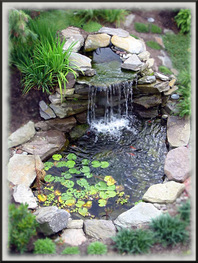 The Benefits of Pond Magician
As these beneficial microorganisms carry out their job, your pond will receive the subsequent advantages:
- The pond is going to have an extremely enjoyable, refreshing aroma.
- The pond water is going to be as healthy and crystal clear as water coming down a flowing mountain stream.
- The plants and fish will be extremely pleased and live longer.
Over dosage Precautions
Essentially, there is absolutely no chance of overdose due to the fact Pond Magician is made up of beneficial microorganisms. On the other hand, using more than needed will become significantly less cost-effective to the customer. In contrast to chemical products, where there exists a devastating consequence when overdosing occurs, organic bio-solutions only will stop functioning whenever there isn't enough excessive nourishment within the pond.
The main issue linked to overdosing beneficial microorganisms, besides cost, is the fact that when there is a great deal of natural and organic accumulation when you overdose, it is possible to induce an excessive amount of activity and need for oxygen. Basically, an over dosage of microorganisms would use up the oxygen in the water that sustains the fish. 
Algae: The Leading Cause of Fish Deaths in Ponds
by Clifford Woods 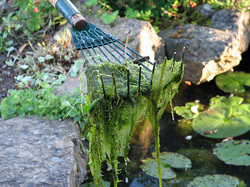
Fish pond algae are really a general name which represents all of the various types of algae, normally present in ponds. A few varieties of algae can actually be beneficial to the overall health of the pond while others types can be viewed as a real annoyance.
You will need to prevent as many algae blooms as you can in order to keep your fish and visual appealing pond vegetation alive. The most prevalent type is the floating green algae, like chlorella, euglena, and chlamydomonas varieties. They grow and reproduce quickly through cell division or spores.
Filamentous algae, also known as string algae, appear to be lengthy green noodles and have a hair-like visual aspect to them. The looks are a result of a combination of cells joined up end to end. Horse hair algae and blanket weed types like spirogyra, oedogonium, and cladophora are quite prevalent.
The Factors That Lead to Pond Algae Growth
The main three variables that enables pond algae to produce consists of: hot temperatures, vitamin abundant pond water, and crystal clear pond water that permits sunshine to pass through. A rise in temperatures speeds up both blanket weed and suspended green algae advancement.
How Various Algae Varieties Affect the Overall Health of the Fish Pond
Floating planktonic algae distribute at a speedy pace and can only be managed by ultraviolet illumination from a UV sterilizer. The UV spectrum splits the cell surfaces, resulting in the algae to collect together which in turn allows filters to easily remove the algae from the pond. An substantial amount of floating green algae can produce what is known as algae blooms. They could be devastating to pond fish as the blooms will at some point deprive the pond of oxygen thus killing off all underwater plants and fish life. 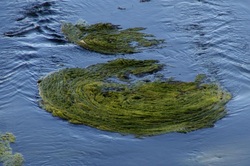 Why Too Much Algae is Harmful for Garden Ponds
Algae does not just make the pond seem unpleasant and overgrown, but in more severe situations, can actually cause the pond to smell foul. The rotting process of algae eats up oxygen from the pond water. This is especially harmful to the oxidizing bacteria and pond fish population, which both need oxygen to thrive.
Keep in mind that ammonia must be changed into nitrites by the oxidizing microorganisms. The oxidation procedure calls for vast volumes of oxygen to be able to take place. The rise in ammonia, which is additionally created by decaying algae matter, puts even more stress on the pond filtration system that houses the nitrifying microorganisms.
 How to Control Algae in Your Fish Pond
By far the most effective way of handling suspended planktonic algae is to make use of a UV clarifier or UV sterilizer. The ultraviolet spectrum eliminates the single-celled algae, resulting in it expiring and sticking to other deceased algal cells.
However, UV does not discriminate between good and bad microorganisms and will simply kill all of them. This is not really good for your fish. And not all algae are bad for a fish pond ; in fact, algae can be quite helpful to the pond because it supplies a way to obtain food for fish, presents shade from the sizzling sun, and offers as a shelter from king fishers, heron, along with various other birds.
Make an effort to cover a minimum of one third the surface area of the fish pond with plants, since they contend with algae cells for the accessible vitamins in the pond water.
Conduct regular cleaning by getting rid of string algae and blanket weed by using a garden rake.
It really is alright to have a bit of algae on pond surfaces, filtration systems, as well as other pond maintenance gear. The key is to keep it in check with a probiotics solution such as an organic algaecide created with beneficial microorganisms.
 Clifford Woods is the CEO of Effective Environmental Services
and Organic Environmental Technology.
We brew Beneficial Microorganisms that eat toxins and offer Naturally Organic Solutions.
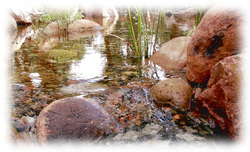 My All Natural, No-Chemical Pond Never Turns GreenBy Clifford Woods"My all-natural, no-chemical pond never turns green" is a statement made by our Founder's wife about their pond. She uses Pond Magician and Magic Sinkers all-year-round!This astonishing statement got me curious! I knew the products worked; but never turns green? This I had to find out more about. So, being naturally curious I asked her how they did it. She explains how they keep their pond fresh and clean all-year-round with naturally organic products.No Chemicals tips for a clean, naturally organic pond that you and your fish will love!The first point is NEVER put any chemicals what-so-ever in your pond. They damage the environment; destroy natural vegetation and they can HARM your fish! If you are currently using chemicals, it is strongly recommend that you cease using them. At the very least, they are not safe for the environment.No Ultra Violet Lights - ever. Ultra Violet light does reduce the bacteria in the pond; however, the UV cannot tell the difference between the good bacteria and the bad ones. Because of this, a UV light kills the friendly bacteria in the Pond and in the Pond Magician - right along with the bad guys!Use your dechlorinator. If your water is chlorinated or every time you add fresh water to your pond; dechlorinate. Chlorine is not good for the microbes in the Pond Magician.No sludge build-up! Because she uses Pond Magician - about once every 6 weeks or so, no black, stinky, smelly sludge builds up on the bottom of the pond.When asked to elaborate on the pond itself, she said we have a 2500 gallon pond and that she always uses Pond Magician, at the recommended dosages, every 6 weeks or so, ALL-YEAR-ROUND!Pond Magician cleans ponds, helps to control algae by "competitive exclusion" of harmful bacteria, all the while enhancing the whole environment of your pond. It is a natural organic pond cleaner that cleans ponds, lakes, fresh & salt water aquariums and because of it's probiotic value, it benefits your fish and plants as it works.Pond Magician is very easy to use! Just pour it into the pond straight from the bottle. Pour a little at a few places around the edge of the pond or pour it into the stream or waterfall if you have one. The idea is to get the product evenly dispersed in the pond. You can also spray it onto the pond surface with a garden sprayer. This helps if you have a lot of surface algae.Using Pond Magician, at the recommended dosages, all-year-round (every 6 weeks or so) and keeping your pond dechlorinated whenever you add fresh water, will give you:- happy fish
- thriving and beautiful plants
- no green water
- a clean, healthy, beautiful pond all-year-round!
|















 RSS Feed
RSS Feed